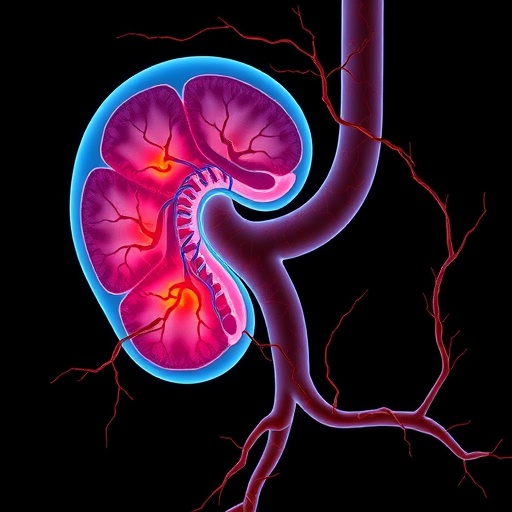
A groundbreaking study published in the latest issue of npj Parkinson’s Disease unveils a promising biomarker capable of forecasting cognitive decline and striatal dopamine depletion in Parkinson’s disease (PD) patients. This revelation centers around the triglyceride-glucose (TyG) index—a biochemical marker traditionally used for assessing insulin resistance and metabolic dysfunction. By linking metabolic health directly to neurodegeneration, this research opens new vistas for early diagnosis and potentially targeted therapeutic strategies in one of the most complex neurodegenerative disorders.
Parkinson’s disease, long characterized by its motor symptoms resulting from dopaminergic neuron loss in the striatum, also encompasses a devastating non-motor component: cognitive impairment. Cognitive decline severely compromises quality of life and accelerates PD progression but remains difficult to predict accurately. The challenge lies in identifying readily accessible biomarkers that reflect ongoing neurodegenerative processes and cognitive trajectory. Enter the TyG index, an easily measurable blood parameter combining fasting triglyceride and glucose values, historically used as a cardiometabolic risk indicator.
The research team led by Cao, Zhao, Chen, and colleagues conducted a comprehensive, multi-cohort investigation involving Parkinson’s patients closely monitored for both metabolic parameters and detailed neurological assessments. The study meticulously correlated the TyG index with longitudinal cognitive testing outcomes and neuroimaging biomarkers of dopaminergic function. Across two independent cohorts encompassing hundreds of PD patients, a higher TyG index robustly predicted accelerated cognitive decline and lower dopamine transporter availability in the striatum—a critical hub regulating motor and cognitive circuits.
.adsslot_QCymRTigh8{width:728px !important;height:90px !important;}
@media(max-width:1199px){ .adsslot_QCymRTigh8{width:468px !important;height:60px !important;}
}
@media(max-width:767px){ .adsslot_QCymRTigh8{width:320px !important;height:50px !important;}
}
ADVERTISEMENT
This correlation highlights a crucial intersection between metabolic syndrome components and neurodegenerative progression, challenging the traditional separation of metabolic and neurological diseases. Insulin resistance, compounded by elevated triglyceride levels, may exacerbate oxidative stress, mitochondrial dysfunction, and neuroinflammation within the nigrostriatal pathway, accelerating dopamine neuron loss and impairing cognitive networks. The TyG index, therefore, emerges as a surrogate marker encapsulating these intertwined pathological mechanisms.
Mechanistically, the study dives into potential pathways by which metabolic derangements influence neurodegeneration in PD. Elevated blood glucose and triglycerides contribute to systemic inflammation, endothelial dysfunction, and blood-brain barrier compromise. These changes facilitate neurotoxic exposure and diminish neurotrophic support essential for dopaminergic neurons. Furthermore, insulin signaling disruption within the brain impacts synaptic plasticity and cognition, providing a plausible link between systemic metabolic indices like TyG and central dopaminergic deficits.
Neuroimaging techniques employed in the study, particularly dopamine transporter single-photon emission computed tomography (DAT-SPECT), provided vital quantitative evidence of striatal dopamine scarcity correlating with TyG elevations. The integration of biochemical markers with functional imaging underlines a multidimensional approach toward biomarker development, ensuring higher predictive accuracy than either method alone. This fusion could revolutionize patient stratification and disease monitoring in clinical settings.
Intriguingly, the study also sheds light on the temporal dimension of metabolic dysfunction in PD. Elevated TyG indices were detectable before significant cognitive symptoms appeared, suggesting its utility in preemptive intervention frameworks. This early detection potential is of paramount importance since current pharmacological treatments remain largely symptomatic and ineffective in halting cognitive deterioration. Identifying at-risk individuals via metabolic profiling could accelerate inclusion in neuroprotective trials.
The implications of these findings extend beyond Parkinson’s disease. They advocate for a holistic view wherein metabolic health profoundly influences neurodegeneration, potentially applicable to other disorders characterized by dopamine deficiency and cognitive decline, such as Alzheimer’s disease and vascular cognitive impairment. This paradigm shift calls for integrated clinical approaches combining endocrinology and neurology.
Moreover, the study invites further investigation into therapeutic avenues targeting metabolic pathways. Lifestyle modifications improving insulin sensitivity and lipid profiles, combined with emerging pharmacotherapies addressing metabolic-inflammation axes, might slow or prevent dopaminergic neuron loss. Future randomized controlled trials inspired by these observations could transform PD management, emphasizing prevention and personalized medicine.
This research also compels a reevaluation of routine clinical monitoring. Measuring the TyG index, a simple and cost-effective blood test, could become standard practice in Parkinson’s clinics worldwide. Regular metabolic screening may identify patients at elevated risk of cognitive impairment, enabling tailored cognitive rehabilitation or pharmacological strategies.
The utilization of two independent cohorts strengthens the reliability and generalizability of the findings. Heterogeneity in sample demographics, disease duration, and clinical profiles were accounted for, ensuring robustness. This methodological rigor addresses past limitations in biomarker studies prone to confounding variables and cohort bias, marking a milestone in PD biomarker research.
Importantly, the study illuminates potential mechanistic underpinnings warranting deeper exploration. For instance, delineating how triglycerides specifically modulate dopaminergic neuron vulnerability versus generalized systemic effects remains an open question. Similarly, dissecting the role of brain insulin resistance in differential regional neurodegeneration patterns could optimize therapeutic targeting.
Parallel lines of inquiry may investigate whether TyG index modifications through pharmacological or lifestyle interventions translate to measurable improvements in dopamine transporter integrity and cognitive outcomes. Longitudinal interventional studies integrating metabolic and neuroimaging markers could clarify causal relationships presently inferred from observational correlations.
Clinicians and researchers alike are encouraged to contemplate the broader interface between peripheral metabolic disturbances and central nervous system pathology illuminated by these findings. The TyG index symbolizes a beacon guiding integrated care strategies capable of addressing the multifaceted nature of Parkinson’s disease progression.
In conclusion, this pivotal study not only identifies the triglyceride-glucose index as a harbinger of cognitive decline and striatal dopamine deficiency in Parkinson’s disease but also pioneers a paradigm that intertwines metabolic health with neurodegenerative dynamics. By bridging distinct physiological domains, it heralds a new era in understanding, diagnosing, and potentially mitigating one of the most challenging aspects of Parkinson’s disease—cognitive impairment.
Subject of Research: Parkinson’s disease, cognitive decline, striatal dopamine deficiency, and metabolic biomarkers
Article Title: Triglyceride-glucose index predicts cognitive decline and striatal dopamine deficiency in Parkinson disease in two cohorts
Article References:
Cao, H., Zhao, Y., Chen, Z. et al. Triglyceride-glucose index predicts cognitive decline and striatal dopamine deficiency in Parkinson disease in two cohorts. npj Parkinsons Dis. 11, 240 (2025). https://doi.org/10.1038/s41531-025-01100-1
Image Credits: AI Generated
Tags: biomarkers for neurodegenerationcognitive impairment in Parkinson’sdopaminergic function assessmentearly diagnosis of Parkinson’s Diseaseinsulin resistance and Parkinson’slongitudinal cognitive testing in Parkinson’smetabolic health and cognitionmulti-cohort study on Parkinson’s diseaseneuroimaging biomarkers in PDParkinson’s disease cognitive declinetherapeutic strategies for PDtriglyceride-glucose index





